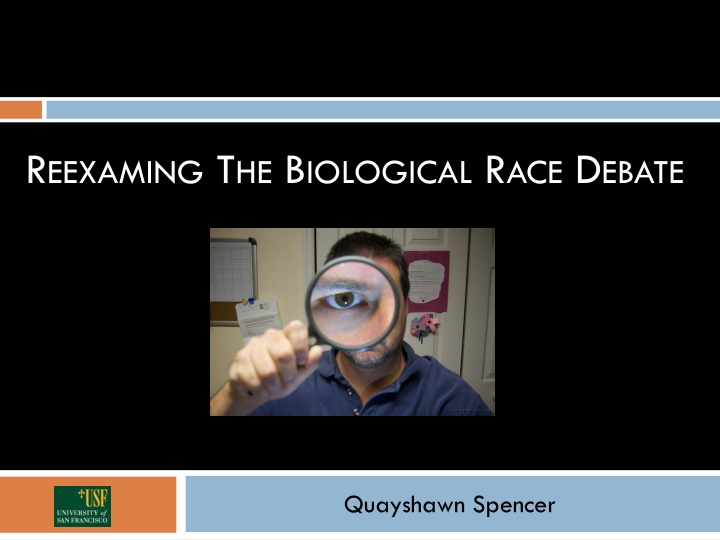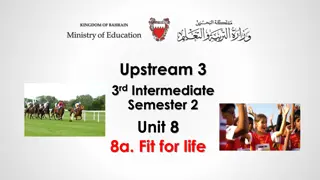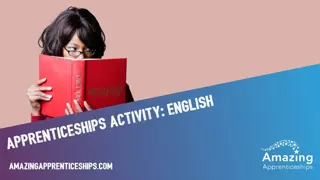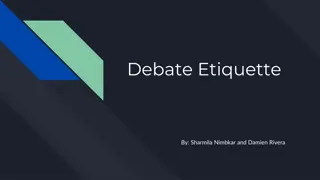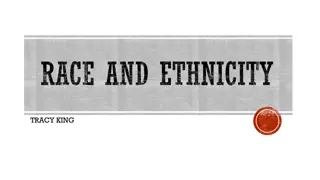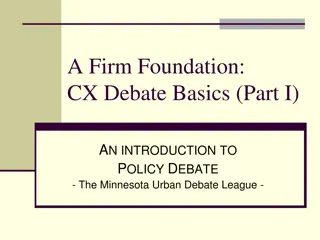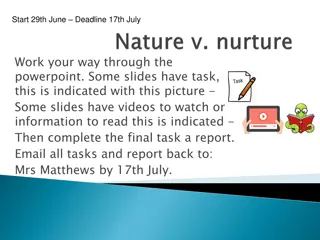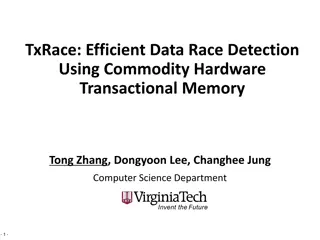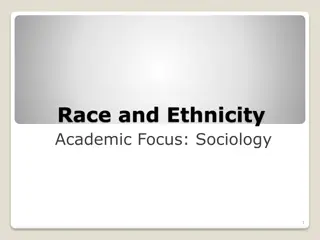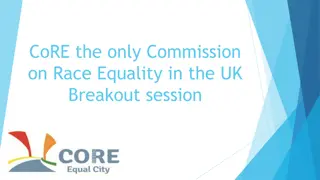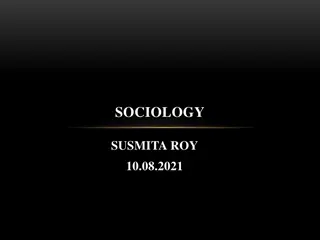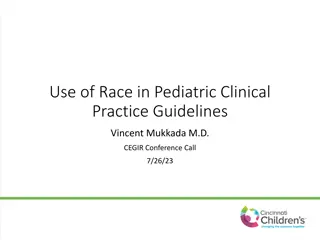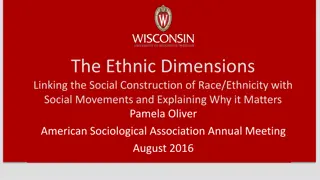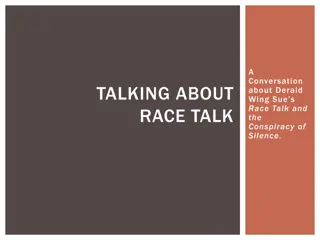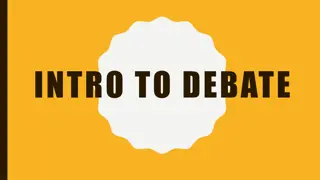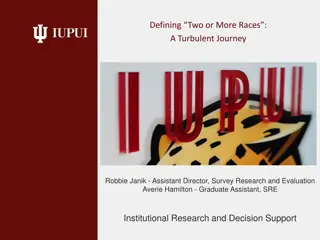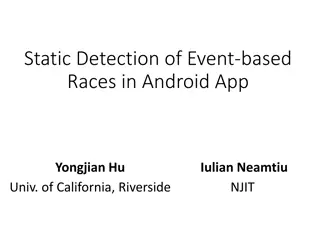Reexamining the Biological Race Debate by Quayshawn Spencer
Quayshawn Spencer reexamines the biological race debate, discussing the onto-semantic strategy, its problems, and applications to public health genomics. The philosophical foundations of biological racial anti-realism are critiqued, exploring the concept of race through historical perspectives like Kant's views and the three major stances of biological racial realism, social constructivism, and racial anti-realism.
Download Presentation

Please find below an Image/Link to download the presentation.
The content on the website is provided AS IS for your information and personal use only. It may not be sold, licensed, or shared on other websites without obtaining consent from the author.If you encounter any issues during the download, it is possible that the publisher has removed the file from their server.
You are allowed to download the files provided on this website for personal or commercial use, subject to the condition that they are used lawfully. All files are the property of their respective owners.
The content on the website is provided AS IS for your information and personal use only. It may not be sold, licensed, or shared on other websites without obtaining consent from the author.
E N D
Presentation Transcript
REEXAMING THE BIOLOGICAL RACE DEBATE Quayshawn Spencer
Outline 2 Thesis Background The Onto-Semantic Strategy Four Problems with the Onto-Semantic Strategy Observation Conclusion Applications to the Public Health Genomics Race Debate
Thesis 3 The philosophical foundations of biological racial anti-realism are shaky at best.
The Race Debate 5 What is a race? (Kant 1775) Does race exist? If so, how? Biological Racial Realism, 1775 Social Constructivism, 1897 Racial Anti-Realism, 1992
The Onto-Semantic Strategy 13 The joint metaphysical and semantic strategy of showing that no real biological kind is also a classification of race as ordinarily understood. It is the most sophisticated defense of BR anti- realism in contemporary philosophy.
The Seven Steps of The Onto-Semantic Strategy 15
Step 1: Figure Out How to Figure Out the Folk Meaning of Race 16 Step 1a: Select the theory of meaning that best models the folk meaning of race . Descriptivism v. Referentialism Racial descriptivists. The folk meaning of race is its definite description in folk discourse. e.g. Races are necessarily groups that differ in visible physical features of the relevant kind (Glasgow 2009). Racial referentialists. The folk meaning of race is its referent in folk discourse. e.g. Races are Black, White, Asian, and other groups like that (Haslanger 2008).
Step 1 17 Step 1b. Select the best method for marshaling evidence for a hypothesis about the folk meaning of race . The armchair approach. Conceptual analysis is the best approach (e.g. thought experiments). The abductive strategy. Race is whatever best explains folk racial phenomena (e.g. passing, visibility, etc.). The historical strategy. The meaning is best determined by historical work. The experimental approach. Controlled experiments are the best way to determine the meaning.
Step 2: Figure Out the Folk Meaning of Race 18 Using the theory of meaning from step 1a and the evidential method in step 1b
Step 3: Define Real Biological Kind 19 Natural kinds v. Pragmatic kinds Natural kind. A kind that exists independently of human thought and language. e.g. Appiah (1996) & Zack (2002) Pragmatic kind. A kind that is useful in a certain epistemic context. e.g. Haslanger (2008)
Step 4: Compile a List of Candidates 20 e.g. Glasgow (2009) considers Andreasen s cladistic subspecies, Kitcher s lineage subspecies, Risch s genetic clusters of populations, etc.
Step 5: Elucidate Each Candidate 21 e.g. A cladistic subspecies is a monophyletic group of breeding populations in a biological species (Andreasen 1998). e.g. Human cladistic subspecies are Caucasians, Amerinds, Pacific Islanders, sub-Saharan Africans, etc., but not Asians or Latinos.
Step 6: Set a Reasonable Overlap Standard 22 Set a reasonable semantic standard for when a scientific kind is not the referent of an ordinary kind term. e.g. Glasgow s (2009) non-negotiability standard.
Step 7: Eliminate Each Candidate 23 Show that no candidate from step 4 is both a real biological kind, according to step 3, and the referent of race , according to steps 2, 5, & 6.
Example 24 Glasgow, A Theory of Race (2009) Descriptivist armchair approach Folk race is a human division based on visible physical features of the relevant kind. A real biological kind is a kind that is not biologically arbitrary (BA). A BA kind is a kind such that the biological facts do not give us sufficient reason to mark off that kind .
Example (cont.) 25 Candidates: superficial theory, genetic racial realism, & populationism Non-negotiability semantic standard Superficial theory, genetic racial realism, & constrained populationism are not RBKs. Unconstrained populationism is not a theory of folk race. Q.E.D.
Four Problems with the Onto-Semantic Strategy 26
Problem 1 27 Descriptivism is an inappropriate way to model the folk meaning of race . It s not clear that the folk concept of race is even coherent. It s not necessary to have certain mental content to be a competent user of race .
Problem 2 28 The armchair method is inappropriate in our case. It s bound to be unrepresentative of the folk s notion because race isn t well-behaved like say human .
Problem 3 29 There s no appropriate account of real biological kindhood. Natural kinds rig the debate in favor of BR anti- realism. Nobody knows whether such kinds even exist. Nobody knows how to identify them even if they do exist. Pragmatic kinds are too easy to come by. e.g. baramin is a RBK under a pragmatic kind view
Problem 4 30 The reasonable overlap standards used are unreasonable.
Example 31 the hypothesis that there are human folk races is the hypothesis that there are human groups of common ancestry that are (roughly) definable by shared inherited intrinsic properties. It s a consequence of this stipulation that biological subspecies, at least as many evolutionary biologists have conceived of them, are not likely to be folk races. That s because membership in a subspecies is not an intrinsic property, but a relational one (Appiah 2006, 366).
Observation 32 No BR anti-realist has used a non-descriptivist, non- armchair, non-natural kind, non-pragmatic kind, and a truly reasonable semantic overlap standard to defend BR anti-realism.
Conclusion 33 The philosophical foundations of biological racial anti-realism are shaky at best.
Applications to the Public Health Genomics Race Debate 34
The Question 35 To what extent, if any, is folk race a real biological kind in the context of public health genomics (e.g. pharmacogenomics, genetic epidemiology, etc.)?
Four Recommendations 36 To answer this question we should Be open-minded about the answer because it s not clear that BR anti-realism is true. Focus on folk race, not ethnicity or local population e.g. Tang et al. (2005) study SIRE groups and Taylor et al. (2004) present results for African Americans . Use a referentialist semantics & employ reasonable semantic overlap standards Employ an appropriate notion of real biological kind, not too strict & not too lenient. 1. 2. 3. 4.
The End 37
